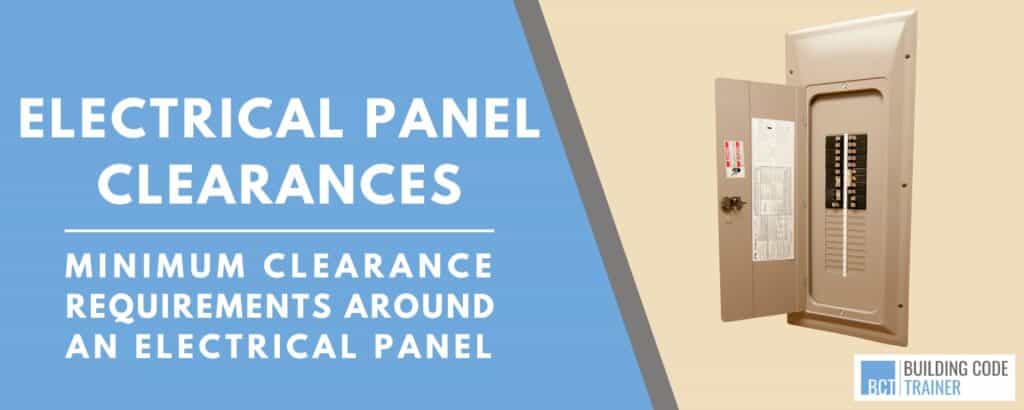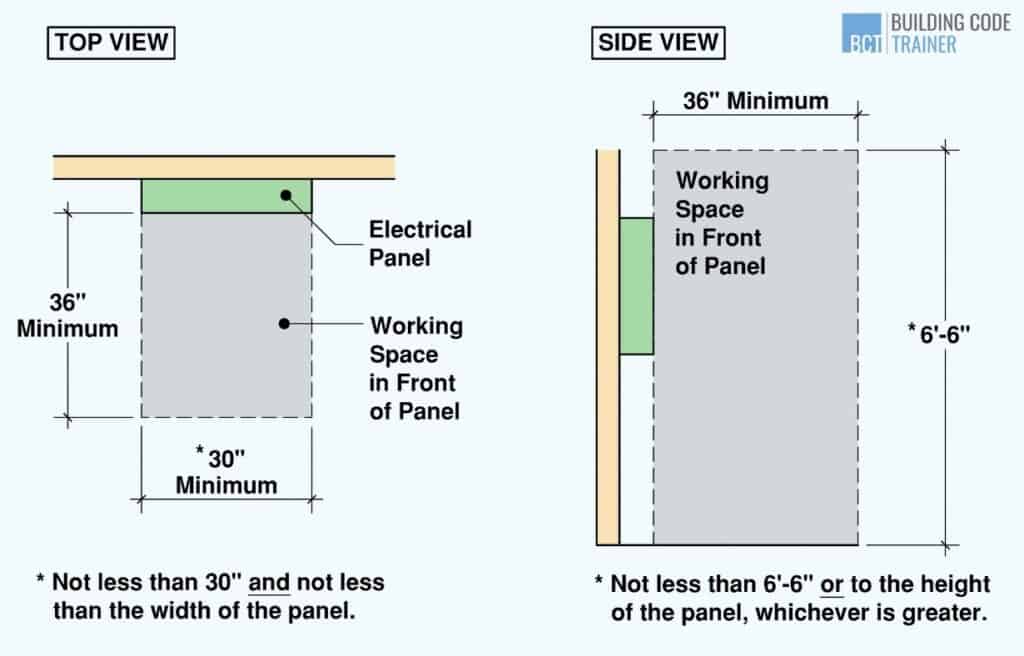Author : Building Code Trainer

Your home’s electrical panel is important and needs to be kept in good working order. Keeping the panel clear of debris and obstructions is crucial to ensuring the safety of your electrical system.
It protects overloading circuits and serves as a central hub where all the wires from your home’s electrical outlets and appliances feed in.
The 2021 International Residential Code (IRC) requires electrical panels to have a clear working space to ensure safe operation and maintenance can be provided.
Specifically Section E3405 outlines proper panel location and minimum clearances that are to be maintained in residential structures subject to the IRC.
What Are the Working Clearance Requirements Around an Electrical Panel?
Whether you’re updating an electrical panel or installing a new one, ensuring that there’s plenty of room plays a crucial role in ensuring the safe operation of your electrical system. The working clearance is the minimum amount of space required to access the panel safely.
Section E3405.2 lists out 3 main dimensions to me mindful of in order to establish a minimum working space in front of the panel.
Depth Clearance
Provide at Least 36 Inches of Working Space in Front
The 3 foot requirement for electrical panel clearances is the most important one to follow. The panel should be accessible and have enough room in front of it so that an electrician can open the door and work safely. This area needs to remain clear at all times.
With that being said, there shouldn’t be any furniture, storage items, or other obstructions blocking this working space. This also includes walls, or any other permanent fixture that would make it difficult to access the panel.
Width Clearance
Provide At Least 30 Inches of Width in Front
The panel should also have a minimum of 30 inches in width, and at least the width of the electrical panel. This will give enough room to maneuver around the door, so there’s no problem accessing switches or breakers. Additionally, this provides space for tools and other materials needed when working on the panel.
Vertical Clearance
Provide At Least 6 ½ Feet of Vertical Clearance
The panel also needs to have a vertical clear space extending from the floor to a height of 6.5 feet or to the height of the equipment, whichever is greater. This way there is enough room to access it without having to crouch down or reach too high. Ensuring plenty of headroom is provided is essential for safety reasons.
It is important to note however that there are some exceptions to this for spaces that might have limited access. These requirements can also be found in Section E3405.2 of the IRC.

One final thing to note here is the door of the panel. The code requires the panel door to open at least 90-degrees to allow for proper working clearance. This way the panel door itself does not obstruct the panel clearance.
Prohibited Locations for Electrical Panels
Section E3405.5 of the International Residential Code prohibits the location of electrical panels from being installed in the following locations:
- Clothes closets
- Bathrooms
- Over the Steps of a Stairway.
The reasons for this are obvious. A clothes closet can store combustible material that can easily be ignitable, a bathroom is problematic due to moisture being present, and placing a panel above a step can be a potential fall hazard to the individual servicing the equipment.
This section also notes that the working space shall not be used for storage and must be kept clear at all times. Another clear reason why a panel cannot be located in the clothes closet.
Reasons Why Proper Working Clearance Is Important
You may not have heard about any of these before, not until you’ve decided to upgrade your home’s electrical panel or install a new one. However, following these guidelines are needed for these reasons:
Safety
First and foremost, having proper working clearances always ensures safety. This doesn’t just keep your electrical system safe but also helps to prevents any injury or hazard when an electrician or homeowner attempts to work on the panel.
Accessibility
Having an appropriate amount of working clearance makes it easier for electricians to access the panel and perform any repair or installation work quickly and easily. This will help prevent problems that may arise from not being able to reach switches, breakers, or conductors within the panel.
When the electrical panel is easily accessible, it allows electricians to perform their work smoothly and efficiently. This helps complete the job faster, which in turn can save both time and money for everyone involved.
Other Important Tips to Remember When Installing or Upgrading An Electrical Panel
Aside from the working clearance requirements, here are some other tips to remember when upgrading your electrical panel:
1. Install in an Area that the code does not Prohibit
When installing or upgrading an electrical panel, it should be placed in an area that the code does not prohibit. As discussed above, the IRC prohibits the location of electrical panels from being installed in clothes closets, bathrooms, or over the steps of a stairway.
2. Label All Breakers, Switches, and Conduits Properly
Labeling all breakers, switches, and conduits properly is also important. This helps ensure that all circuits are connected correctly and enables electricians to easily identify the correct connections when working on the panel.
These tips will help ensure that your electrical panel is installed or upgraded safely and efficiently.
3. Choose the Right Circuit Breakers and Wiring Type
Finally, selecting the right circuit breakers and wiring type is essential when installing or upgrading an electrical panel. Using a circuit breaker that’s too small can lead to overload, while using one that’s too large can cause a potential fire hazard.
Similarly, the wiring type should also be appropriate for the intended usage and should meet local safety codes and regulations. This helps ensure that your electrical system is adequately protected and is running safely.
4. Always Hire a Certified Electrician for Any Installation or Repair Work
Most of the time, getting up to code and understanding all the basics for installing or upgrading an electrical panel can be difficult for homeowners. That’s why it’s important to always hire a licensed electrician to handle these types of work.
A professional electrician will have the experience and knowledge needed to install or upgrade your electrical panel correctly, safely, and by local codes and regulations. This means they’re knowledgeable about the working clearance requirements and can help ensure that you get the best performance out of your system.
Having a professional electrician also ensures that any repair or installation work done is up to standard, which helps prevent any future problems or safety hazards.
Final Thoughts
Installing or upgrading an electrical panel can be daunting, especially if you’re unfamiliar with the working clearance requirements. One can easily get overwhelmed by all the technical details of getting an electrical panel up to code.
With that being said, it’s always important to hire a licensed electrician to handle any installation or repair work. While it’s worth knowing the basic requirements for electrical panel installations, it’s better to leave the technical details and the job itself to a professional. This way, you can be sure that the work is done correctly, safely, and up to all local codes and regulations.
For more information, see Section E3405 of the 2021 International Residential Code for a more in-depth look at electrical panel requirements.
Related Articles to Read:
- How To Tell If Your Circuit Breaker is a Bad Breaker?
- GFCI Bathroom Outlet | Where Must it Be Located?
About the Author

Building Code Trainer
AuthorThis site is run and maintained by a Certified Building Official, Plans Examiner, and Inspector. With a Bachelors of Science Degree in Construction Engineering along with holding multiple ICC certifications, the Author of this site has over 15 years of experience within the construction industry.
